Thank goodness I caught the typo in “makeshift lab,” that would have been embarrassing.
So when last we met, I had a lot to say about Swamp Thing comics and their treatment of superheroes, which hopefully you all were able to appreciate amongst all the typos*. I was a tad dismissive, in particular, of the Supeman/Swamp Thing “team-up” in DC Comics Presents #8 from 1979, which I described as a typical Superman comic that Swamp Thing happened to be in, and not reflective of the tonal shift superheroes would receive in the post-Alan Moore era of Swampy’s title.
Anyway, thanks to the DC Universe streaming service (as I’m not really able to read print comics due to my eyeball stuff) I was able to reread that issue for the first time in…gosh, a decade, maybe? And it turns out my memory of that book was just a tiny bit wrong.
I’ll explain, but just so we’re on the same page, as it were, and because there was some minor confusion over this point when I posted about it last Friday, the DC Comics Presents issue I’m talking about is not this one from 1985 by Moore, Rick Veitch and Al Williamson that everyone remembers:
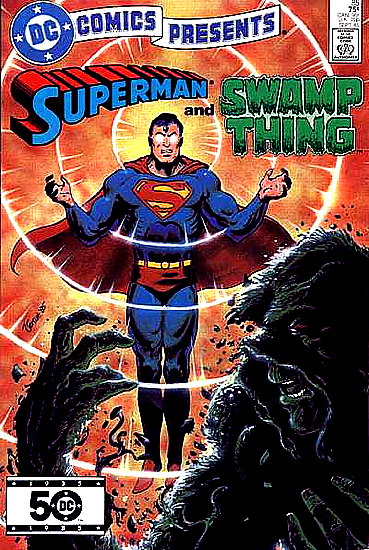
…but, rather, this one from, as I said, 1979, by Steve Englehart and Murphy Anderson:
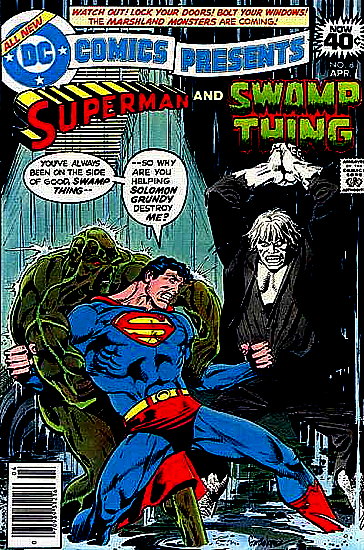
Now it does, on the surface level, look like a typical Superman comic. Supes is drawn in the traditional way (both inside by Anderson and on that greaet cover by Jose Luis Garcia-Lopez), he’s fighting a supervillain, it’s in Metropolis, there’s Janet Klyburn from S.T.A.R. Labs, there’s Lois, etc. Oh, and there’s Swamp Thing, drawn in a style that fits right in with Superman’s world, the one concession to his mystery book origins being the drippy caption boxes:
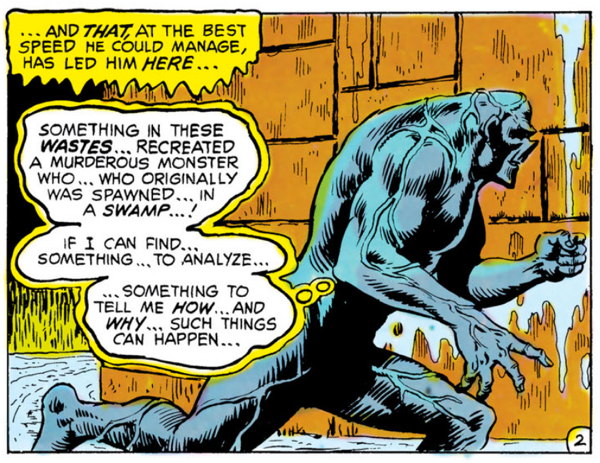
Okay, and let me get this out of the way. The thing that bothered me about this issue when I first read it sometime in the early 1980s, more than anything else, and way out of proportion to the actual offense, is that Swamp Thing’s thought balloons are colored incorrectly. They’re supposed to be yellow on the inside, with the white outline. His speech balloons (all two of ’em) in this issue are drawn and colored the same way, and not as the jagged orange word balloons from the original comics. …I’m bothered less by it now, as I’ve mellowed in my old age, so let’s move on.
The general plot of the story is that Swamp Thing (who at this point still believes himself to Dr. Alec Holland, transformed by a hideous mishap of science into this muck-encrusted mockery of a man) learns about another swamp creature, Solomon Grundy, running around in Metropolis and causin’ trouble. Swampy wants to get his hands on Grundy and run some tests, hoping to find a cure for his condition, which brings him into conflict with Superman, who would take Grundy away and out of his reach:
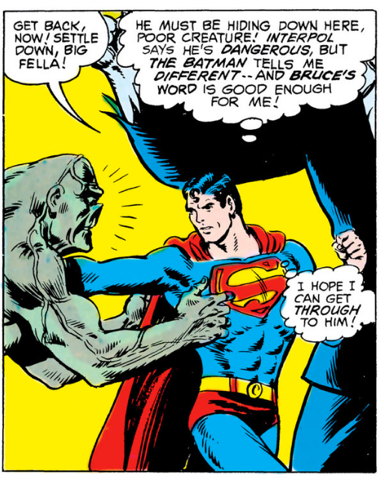
As it turns out, there is some chemical hoohar in the sewers of Metropolis that is spontaneously generating duplicates of Grundy, who are running amock in the streets, forcing Superman to take drastic measures.
Eventually, Swamp Thing’s tests (using a makeshift lab he somehow built in the sewer tunnels) revealed what Superman already know, that Solomon Grundy and these duplicates aren’t really alive, but are instead, well…
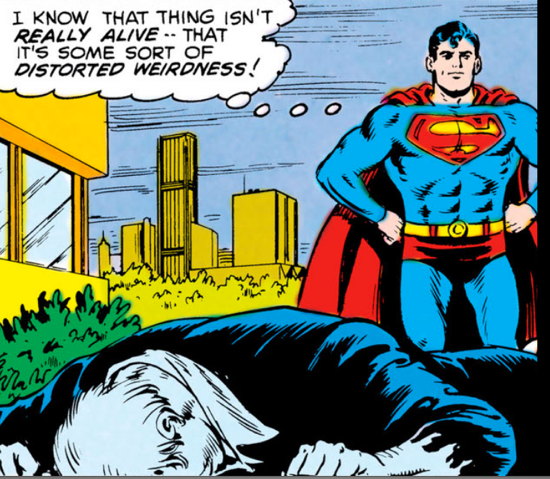
I believe that would be the scientic term for it, yes.
Thanks to Dr. Klyburn at S.T.A.R. Labs, Superman has something-or-other that will destroy all these Grundy duplicates on contact that he can just fly around at super-speed and apply to them, saving himself the trouble of any more destructive brawls with a creature nearly as strong as he is. But when Swamp Thing hears of this plan:
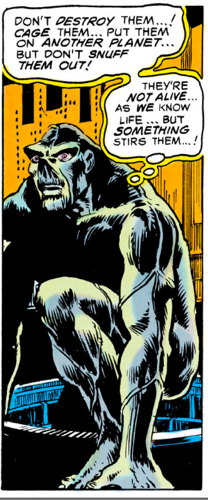
He rushes to stop Superman from enacting this plan:
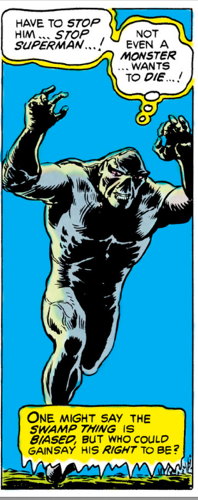
…but his attempt at getting the Man of Steel’s attention is futile:
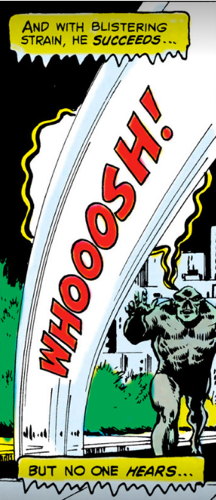
…and Superman flies off and does the ol’ scrubbing bubbles thing on the Grundy menace:
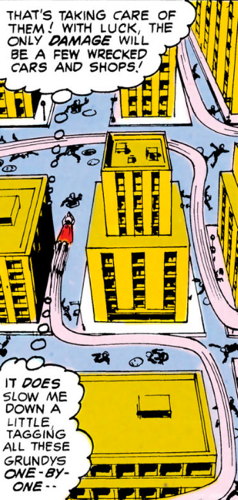
Ultimately, in its way, this story is a definite precursor to the reinterpretations of DC’s superheroes we begin to see in the previously discussed Saga of the Swamp Thing #24. The Superman comics have always made a a big deal out of his code against killing, while also giving him regular “outs” to allow him to, well, kill things when he needs to (“oh, it’s just a robot,” “oh, it’s just some imitation of life,” “oh, it’s distorted weirdness”).
Solomon Grundy not being “alive” seems to be a case of splitting hairs…he moves, he thinks, he demonstrates understanding of concepts like “friend” and “foe” — that panel above, Swamp Thing realizes that it may not be specifically life as we know it, but it’s something. When Superman flies off to do his thing and save the day, freed by his belief that he’s not really kiling anything, the reader is forced, via Swamp Thing’s perspective, to consider that he is possibly (or, rather, probably) doing the wrong thing, that Superman is just straight-up fundamentally misapplying his code against killing, The story is one of failure: failure of Swamp Thing to prevent the destruction of the Grundys, and Superman’s failure to consider the possibility the Grundys may have some form of existence worth preserving.
I put “team-up” in quotes earlier as, while DC Comics Presents is “the Superman team-up comic,” Superman and Swamp Thing’s inability to team up is what leads to, if not a tragedy, at least a highly ambiguous ending. Without Swamp Thing’s involvement, if it were just a Superman story where he was coping with the same Grundy problem, the reader would likely think nothing of Superman’s solution. With Swamp Thing’s presence, with his point of view added into the mix, we suddenly get a superhero story where the flaws in the genre are brought forward and examined in the comic itself. This is as much a part of the lineage of the “realistic” takes on superheroes we see throughout the eighties and later as anything Moore or Frank Miller or Steve Gerber et al. have done. My mistake in dismissing this issue as long as I have.
Okay, the thought balloon thing still bothers me just a little bit.








Wow, a post ripped from the classic days of the comicsweblogosphere… feels like 2005 in here! (In a good way)
Hope you continue to mend well, Mike. Good luck!
When Grundy turned up early in Rick Veitch’s run on Swamp Thing, this must have been the story that had established that they met before. (I know, I know, actually, the Sprout inhabiting Grundy’s form…) Which led to one of my favorite panels of all time: ST literally gives a big grin and says “Well, if it isn’t Solomon Grundy!” which cracks me up every time.
Okay, here’s the undeniably trivial point that irks me.
“…Swamp Thing (who at this point still believes himself to be Dr. Alec Holland…”
I see this done all the time in fannish discussion, a later writer’s changes being accepted as having been fact all along, and I never like it. The example you provide is not so ridiculous as one I once saw, of someone trying to find in 1960s comics evidence that Starman and Black Canary were having an affair, but it still seems wrong.
Until Alan Moore decided to make Swamp Thing a creature who only thought himself to be Alec Holland, Swamp Thing WAS Alec Holland. That is what Len Wein, his creator, intended. That is the principle under which every writer prior to Moore operated. That was their basis for the characterization. They were not wrong. They were not trying to mislead the readers, or hiding information from them. They were, unequivocally, writing stories about Alec Holland, also known as Swamp Thing.
One can say that, ENDGAME-like, Moore created a new timeline, with a new Swamp Thing. That, however, effects only the future; the stories that came before are still the same.
Turan – I see what you’re saying, but I think, giving the larger context of these latest posts comparing earlier Swamp Thing stories with later ones, I was justified in that particular aside describing the overall state of the character.
“Duplicates of Grundy, who are running amuck”
Is that supposed to be a pun, Mr. Sterling?
ScienceGiant – I blame “Duck Amuck.”
The most gloomy thing about this issue was the lackluster Murphy Anderson art … or maybe it was the lousy printing. But it didn’t look very good.
I first read this story five years later in The Best of DC #54 (Superman Battles Weird Villains!), when the story’s darkness wasn’t as novel.
— MrJM
Mike, please make sure to use “Ctrl” + “+” on the text instead of squinting. Unless you need to squint to find the Ctrl key, in which case this advice is of no help at all…